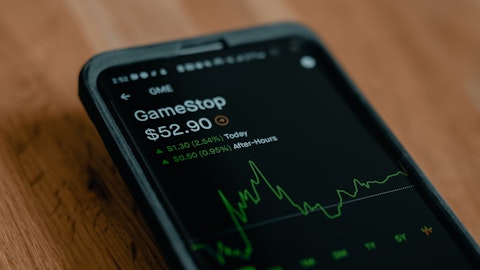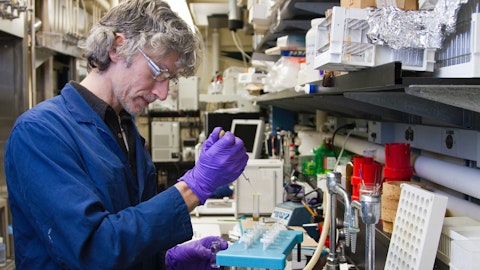bluebird bio, Inc. (NASDAQ:BLUE) Q3 2023 Earnings Call Transcript November 7, 2023
bluebird bio, Inc. beats earnings expectations. Reported EPS is $-0.66, expectations were $-0.69.
Operator: Good day, ladies and gentlemen, and thank you for standing by. Welcome to the bluebird bio Third Quarter 2023 Results Conference Call. At this time, all participants are in a listen-only mode. After the speakers’ presentation, there will be a question-and-answer session. [Operator Instructions] At this time, I would like to turn the conference over to your host, Ms. Courtney O’Leary. Ma’am, please begin.
Courtney O’Leary: Good morning, everyone, and thank you for joining our third quarter results call today. My name is Courtney O’Leary, Director of Investor Relations at bluebird bio. Before we begin, let me review our Safe Harbor statement. Today’s discussion contains statements that are forward-looking under the Private Securities Litigation Reform Act of 1995, including expectations regarding our future financial results and financial position in addition to statements of the company’s plans, expectations or intentions regarding regulatory progress, commercialization plans, and business operations. Such statements are based on current expectations and assumptions that are subject to risks and uncertainties and involve a number of risk factors that could cause actual results to differ materially from projected results.
A description of these risks is contained in our filings with the SEC, which are available on the Investor Relations section of our website, www.bluebirdbio.com. On today’s call, Andrew Obenshain, our CEO, is going to provide some opening remarks on our overall business and potential lovo-cel approval. Then, Tom Klima, Chief Commercial and Operating Officer, will discuss the positive momentum in our ZYNTEGLO and SKYSONA commercial launches as well as launch preparations for lovo-cel. And finally, Chris Krawtschuk, Chief Financial Officer, will provide some color on our financial results, before opening the call up for Q&A. With that, I will turn it over to Andrew.
Andrew Obenshain: Thanks, Courtney, and thank you, everyone, for joining our call this morning. I’m excited today to update you on bluebird’s Q3 results and our preparation for the potential upcoming FDA approval of lovo-cel. This has been a transformative year for the field of gene therapy and for bluebird bio. We validated the commercial model for gene therapy with our ZYNTEGLO and SKYSONA launches. And as a reminder, bluebird occupies unique strategic position as one of the only standalone commercial gene and cell therapy companies with an extensive platform of gene therapy expertise that will potentially enable growth, profitability and expansion for years to come. And we are in incredibly exciting moment for our company, but most importantly, for patients as we approach potential FDA approval of lovo-cel for sickle cell disease in December.
In a minute, Tom and Chris are going to provide more details on our commercial launches and financials, but I want to focus my comments this morning on lovo-cel as we approach this key regulatory milestone. We are six weeks away from our lovo-cel PDUFA date of December 20. This potential approval will be a significant moment for the sickle cell disease community, a major milestone for our company, and, if approved, will be the main driver of profitability for bluebird for years to come. The review remains on-track and our team remains confident in the robustness, maturity of our BLA package for individuals 12 and older with sickle cell disease and a history of vaso-occlusive events, or VOEs. We believe the fact an FDA advisor committee wasn’t requested for lovo-cel is a testament to the breadth and the depth of the lovo-cel data, significantly more than any other gene therapy program for sickle cell disease.
Additionally, this is the third lentiviral vector gene therapy that the FDA has reviewed from bluebird and thus a technology they are very familiar with. Our lentiviral vector technology is also uniquely traceable, giving us an unrivaled understanding of our therapies and the ability to conduct a rigorous monitoring. We understand it can measure how we modify the cell and monitor effects over time. Last week, we announced that in early December, we will be presenting long-term follow-up data from our ZYNTEGLO and lovo-cel programs at the 65th ASH Annual Meeting, with an unparalleled up to nine years of follow-up in transfusion-dependent beta‑thalassemia and five years of follow-up in our sickle cell disease program. We continue to progress plans for our anticipated lovo-cel commercial launch in early 2024 following its potential FDA approval.
With that, I will turn it over to Tom to highlight how our launches are progressing.
Tom Klima: Thanks, Andrew, and good morning, everyone. We have made tremendous progress this quarter and it’s exciting to be here this morning to discuss our commercial advancement in greater detail. For ZYNTEGLO, we continue to see strong linear growth with 16-patient starts or unique cell collection since launch. As a reminder, patient starts remains the key commercial metric to watch in the early stages of the ZYNTEGLO launch as it’s the value creating moment for the company and represents a commitment from the patient. It is our experience that once a patient goes through cell collection, they will continue on the treatment journey, and this will ultimately result in revenue for the company. Our Qualified Treatment Center activation has accelerated this quarter and has nearly doubled since Q2 with 29 QTCs now activated at leading adult and pediatric centers across 16 states.

We remain on track to scale our QTC network to between 40 and 50 by the end of this year as we prepare for the lovo-cel launch. Looking ahead to 2024, we will carry our momentum into the new year, likely continuing to expand our QTC footprint to extend our reach and meet patient demand. We anticipate patient demand for ZYNTEGLO will continue to grow steadily through the end of ’23 and into 2024 as more QTCs are activated and gain experience treating multiple patients. Shifting to reimbursement, I’m thrilled to announce this morning that we have signed outcomes-based agreements for ZYNTEGLO with Michigan and Massachusetts state Medicaid agencies. Additionally, we are finalizing an agreement with the third state which may enable us to reach a large portion of patients with beta-thalassemia.
This significant development demonstrates government payer support for these types of innovative arrangements and eagerness to bring gene therapy to patients. We continue to see strong access for ZYNTEGLO and have received zero ultimate denials across commercial and government payers. Prior authorization approvals for drug product remain consistent at approximately two weeks. All of this progress continues to underscore that payers recognize the value of ZYNTEGLO and the high burden of disease for patients with beta-thalassemia who require regular transfusions. We look forward to closing out the year on a strong note having delivered on every key milestone and anticipate giving 2024 guidance on commercial launch metrics early next year. Moving to SKYSONA, we have completed six patient starts, activated four QTCs, and receive zero ultimate denials from government or commercial payers to date.
We remain on track with our guidance of five to 10 patient starts this year, and anticipate giving 2024 patient start guidance early next year. And, in recognition of growing patient demand we are seeing across ZYNTEGLO and SKYSONA launches, we recently signed an agreement with Lonza to enable increased manufacturing capacity. Shifting to lovo-cel. Preparations are well underway for launch in early 2024, and we are operationally ready to capitalize on our 18-month head start in gene therapy against our nearest competitor. Patients are waiting for this transformative therapy. We have consistently seen strong patient excitement and in market research that more than 70% of patients say they would consider gene therapy if recommended by their doctor.
Demand is clearly there and continues to grow. bluebird has been a trusted partner of the sickle cell patient community for over a decade, and we recently expanded our team as part of an investment in patient education about gene therapy, which was in direct response to patient community feedback. As mentioned, our QTC network, which is 100% synergistic between ZYNTEGLO and lovo-cel, is rapidly scaling. The network can be converted to include lovo-cel within weeks, a key competitive advantage. And our intent is to reach an estimated 65% of sickle cell patients within 50 miles of a planned QTC and 95% within 200 miles of a planned QTC. Moving to access and reimbursement. A particular focus has been on ensuring timely and equitable access to lovo-cel at launch.
bluebird has long been a leader in value-based payment models, and lovo-cel for sickle cell is no exception. We are currently in late-stage negotiations with a number of national payers on our innovative contracting approach. These pending contracts represent a significant percentage of sickle cell covered lives. The positive response we’re seeing in advance of our potential FDA approval underscores payers’ confidence in our offering and the recognized value of lovo-cel, and gives us further confidence as we prepare to make gene therapy available for individuals living with sickle cell disease in early 2024. And finally, on manufacturing, we are applying many learnings from ZYNTEGLO to optimize commercial manufacturing from cell collection through delivery of the therapy back to the hospital.
We are excited about a potential lovo-cel approval next month, and we are well positioned to compete. We plan to share more details on launch plans at that time. And with that, I’ll turn it over to Chris to talk through the financials.
Chris Krawtschuk: Thanks, Tom, and good morning, everyone. As Tom mentioned, to date, there have been 22 combined patient starts for ZYNTEGLO and SKYSONA. This translates over time to a potential $63 million in gross revenue. In Q3, we reported $12.4 million in total revenue, primarily driven by product revenue from ZYNTEGLO and SKYSONA, again, underscoring that strong linear growth. We remain on track with our full-year 2023 cash burn guidance in the range of $270 million to $300 million and continue to prudently deploy capital to bring our therapies to our patients. Additionally, last week, we announced that we have entered into an advanced agreement to sell a priority review voucher if granted for lovo-cel for sickle cell disease for $103 million.
This would be an important source of non-dilutive capital and has the potential to strengthen our financial position ahead of the anticipated launch of lovo-cel. As of September 30, we had $227 million in cash, cash equivalents, restricted cash and marketable securities. Not including the potential proceeds from the PRV sale or the release of our $53 million in restricted cash, we have a cash runway into Q2 of next year. We plan to provide an updated cash runway guidance by early 2024 and continue to explore additional financing opportunities to further extend our cash runway. And with that, I’ll turn it back over to Andrew.
Andrew Obenshain: Thanks, Chris, and thanks, Tom, for walking us through those updates. It’s an exciting time for bluebird as we stand six weeks out from our lovo-cel PDUFA date and our largest opportunity yet, the potential to bring a gene therapy to individuals living with sickle cell disease in the U.S. Looking further into the horizon, we remain committed to our near-term path to profitability and delivering on the promise of bringing potentially curative gene therapies to patients and their families. And with that, we’d like to open it up for questions. Operator?
See also Where Should You Invest $1000 Right Now? and 15 Biggest Renewable Energy Companies in Europe.
Q&A Session
Follow Bluebird Bio Inc. (NASDAQ:BLUE)
Follow Bluebird Bio Inc. (NASDAQ:BLUE)
Operator: [Operator Instructions] Our first question or comment comes from the line of Dane Leone from RJF. Mr. Leone, your line is open.
Dane Leone: Hi. Thanks for taking the questions, and congratulations on all the progress and moving towards the approval of lovo-cel. Maybe a few questions for me. Firstly, could you just give us some color in terms of the patients that were actually infused and recognized as revenues in the quarter? And what the remaining balance is of patients that had cell collections that you would expect to infuse and recognize revenue before year-end? Also just a little bit more color on the general guidance for the remainder of the year? And then, secondly, could you provide us some expectations around R&D burn as it relates to lovo-cel? That’s still probably the biggest bucket of R&D burn on a quarterly basis. Is that expectation that after the approval, the burn will maybe go down a bit, or is there still just obligations given the long-term follow-up required from the clinical studies? Thank you.
Andrew Obenshain: Great. Thanks, Dane. So, I think two questions in there, how the patients infused versus collected and guidance for the rest of the year, and R&D burn and how it’ll change. So, Chris, do you want to address those?
Chris Krawtschuk: Yeah. So, let me start with the patients infused. So, we’ll continue — we’re going to provide cumulative guidance on both ZYNTEGLO and SKYSONA, not individually, because we’re just in the early stages of where we are in our commercial launch. As you see, we’ve infused — we have 22 patient starts in both products. And this translates again to about $63 million in gross revenue, and that will come in over time. Again, our KPI for the company is patient starts. And then, as it relates to your question on what has been deferred in — patient revenue that’s been deferred, it’s about $8.5 million that’s sitting on our balance sheet. And then, can you repeat your question two and three? R&D, I believe?
Dane Leone: Yeah. So, thank you for that. So, just on that subject, the — then correct interpretation of what you just said is there’s $8.5 million of deferred revenue recognition that would still occur before year-end. And would there be incremental revenue recognition beyond that deferred amount? And then, secondly, on R&D, I was just commenting that, in the Q, there’s — I think there’s somewhere around $17 million, $18 million of R&D burn still associated on a quarterly basis with lovo-cel. Is that expected to go lower as we head into 2024 post the approval of the drug, or are there still substantial remaining commitments for long-term follow-up from the clinical studies?
Chris Krawtschuk: Yeah. So, let me take that. So, as it relates to R&D, the predominance of the R&D spend in the quarter contributes to lovo-cel and lovo-cel spend because that product is unapproved. There’s also R&D spend that sits in the R&D line for both ZYNTEGLO and SKYSONA, and that’s attributable to our long-term follow-up, and then any ongoing clinical work associated with the programs that we’ve got today. As it relates to 2024 and beyond, certainly as — if and when lovo-cel gets approved, the R&D expense will go down, and you’ll see those costs coming through either in COGS or inventory, and no longer in R&D. However, there will likely be long-term follow-up and optional patient registry costs for all three programs.
Dane Leone: Thank you, Chris.
Operator: Thank you. Our next question or comment comes from the line of Jason Gerberry from Bank of America Securities. Mr. Gerberry, your line is now open.
Jason Gerberry: Thanks guys for taking my questions. So, when you’re launching lovo-cel, just wanted to understand a little bit more of the dynamics with the Medicaid reimbursement and how you expect that to phase in, how long would that roughly take, and absent Medicaid policies in place at key states, would you just expect revenue recognition to be deferred. So, just if you could speak to those dynamics? And then, appreciate the comments about sort of the 70% of patients more interested, but do you expect there to be an early bolus of sickle cell patients that are pent-up? And when you think about the early launch, just curious if you can speak to that dynamic.
Andrew Obenshain: Yeah. Thanks, Jason. Good morning. I’m going to hand that to Tom to respond.
Tom Klima: Yeah, good morning, Jason. Let me start with the last question first. We would expect that the launch of lovo-cel would look like other gene therapies, specifically would look like the ZYNTEGLO launch, in that we expect strong linear growth. We believe that there is a bolus of patient excitement and patient demand. But as we’ve seen, it just takes time to get patients through the process of getting gene therapy. And then, on top of that, the QTCs, Qualified Treatment Centers, are going to be working through the reimbursement process upfront. So, although we believe there’s a bolus of excitement and bolus of patients that are eager for gene therapy, we would expect it to be a strong linear growth like we’ve seen with ZYNTEGLO.
It’ll be on a much higher scale given that there’s — it’s a much larger patient population and that we already have Qualified Treatment Centers in place, but we don’t expect a bolus like a traditional oncology launch. As far as the Medicaid dynamic, about 50%, we’re estimating, of patients who have sickle cell disease are covered by Medicaid. We have put an outcomes-based agreement in place and are working with both commercial payers and Medicaid payers right now to get the outcomes-based agreement in place hopefully as soon as possible and as close to launch as possible. Clearly, patients who have Medicaid might take a little bit more time than a patient with commercial coverage. But if you reflect back on the ZYNTEGLO launch, we’ve seen no denials either with commercial payers or with Medicaid payers.
So, the yearly patients will go through the medical exception process, and we would expect fair and equitable coverage for patients both in commercial payers and Medicaid.
Jason Gerberry: If I could just squeeze a follow-up in with ZYNTEGLO, were patients on Medicaid getting coverage through medical exceptions before an official policy was in place?
Tom Klima: Yes, that’s correct.
Jason Gerberry: Okay.
Tom Klima: Early in launch there — right now, we have — I believe, it’s 17 states have coverage policies, Medicaid coverage policies. We now have the two outcomes-based agreements with Massachusetts and Michigan. We have a third that’s really close. But early on, patients were going through and getting approved through the medical exception process, and we would expect the same to be true for lovo-cel.
Jason Gerberry: Great. Thanks, guys.
Tom Klima: Thanks, Jason.
Operator: Thank you. Our next question or comment comes from the line of Eric Joseph from JPMorgan. Mr. Joseph, your line is now open.




